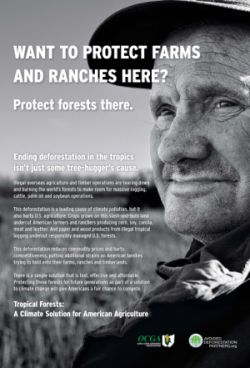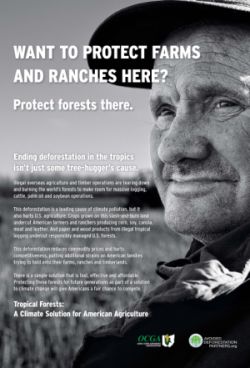 Click to enlarge. “Want to Protect Farms and Ranches Here? Protect them there. Ending deforestation in the tropics isn’t just some tree-hugger’s cause.” Those are the opening lines of a new advertisement campaign run by the Ohio Corn Growers Association and Avoided Deforestation Partners which stresses the need to protect tropical forests in order to protect the competitiveness of U.S. agriculture (see ad to right and click to make it bigger).
Click to enlarge. “Want to Protect Farms and Ranches Here? Protect them there. Ending deforestation in the tropics isn’t just some tree-hugger’s cause.” Those are the opening lines of a new advertisement campaign run by the Ohio Corn Growers Association and Avoided Deforestation Partners which stresses the need to protect tropical forests in order to protect the competitiveness of U.S. agriculture (see ad to right and click to make it bigger).
You may be asking, why is an American farm group supporting efforts to stop tropical deforestation — many, many miles from their home base? The simple answer is (as the ad states):
Illegal overseas agriculture and timber operations are tearing down and burning the world’s forests to make room for massive logging, cattle, palm oil and soybean operations. This deforestation is a leading cause of climate pollution, but it also hurts U.S. agriculture. Crops grown on this slash-and-burn land undercut American farmers and ranchers producing corn, soy, canola, meat and leather. And paper and wood products from illegal tropical logging undercut responsibly managed U.S. forests. This deforestation reduces commodity prices and hurts competitiveness, putting additional strains on American families trying to hold onto their farms, ranches and timberlands [emphasis added].
Tropical deforestation and agriculture. Agricultural expansion is a major driver of deforestation in many developing countries. For example, it is estimated that agricultural expansion — from soy and cattle — accounts for 80 percent of Brazil’s deforestation (and a recent study suggested that 80 percent of the world’s deforestation since 1980 was the result of agricultural expansion). Illegal and unsustainable logging often work in tandem with agriculture to cause deforestation — logging clears the rainforest, selling the wood provides cash for investments in agricultural operations, and then agricultural crops and cattle are introduced into recently cleared land a couple of years after clear cutting. A few years later, more land is cleared as the former rainforest soil is quickly depleted.
How does agricultural expansion in rainforests impact U.S. farmers and ranchers? First, agriculture and forestry products from countries with large deforestation such as Brazil and Indonesia are sold directly into the U.S. These products can compete with goods produced in the U.S. Second, agricultural and forestry products like timber, beef, and soy are globally traded commodities. When these products are sourced from deforested land and sold in the global market, they compete directly with more sustainably produced U.S. exports and impact the market price of those products throughout the world. For example, in 2007 Brazil accounted for 32 percent of the global exports of soybeans* — soybean are one of the major agriculture drivers of deforestation in Brazil. In a sense some agriculture expansion in tropical forests is “subsidized” by lax enforcement of illegal logging and unfettered expansion of agriculture into the rainforests.
This video from Avoided Deforestation Partners shows the dynamics in very helpful way (if you are more of a visual person).
Luckily the House-passed energy and climate bill contains key provisions that aid in slowing and stopping deforestation (as I’ve discussed here) — and Senator Kerry has supported these provisions in bills that he co-authored (as you can see here and here). The bill sets aside 5 percent of the value of allowances from the cap and trade program for deforestation reduction activities in tropical countries and contains provisions for high-quality forest carbon offsets in countries that have developed robust systems to ensure that the reductions are real, additional, verifiable, and permanent. Without the investment in the deforestation set aside, tropical forest countries won’t have near-term resources to build their capacity and develop the robust systems to generate credible offsets (they will never move from a theoretical supplier of offsets to a real supplier). And it will be hard to define a system that doesn’t lead to agriculture and forestry activities simply shifting to non-participant countries — so called “leakage” — which is why the set aside is also designed to support efforts in countries that are susceptible to “leakage” but aren’t eligible for offsets. We need both the set aside and strong rules governing offsets to ensure that offsets based on reducing deforestation are actually reducing global warming pollution across the world and therefore have real value. In other words, this set aside investment is critical to the development of deforestation offsets which aren’t “subprime.”
Slowing the loss of tropical forests, which contributes up to 17 percent of the world’s global warming pollution, is not only good global warming policy, but is also in the interest of U.S. farmers, ranchers, and foresters, as recently recognized by the Ohio Corn Growers, American Forest and Paper Association, National Farmers Union, National Alliance of Forest Owners, American Forest Foundation, Conservation Forestry, Green Diamond, and Hardwood Federation (see letter here).
Hopefully the Senate will take up these provisions and listen to the growing chorus of America’s farmers, ranchers, and foresters that see the connection between reducing tropical deforestation and keeping American agricultural and timber exports strong.
————–
Sasha Lyutse greatly assisted in this post.
* Source: Food and Agriculture Organization of the United Nations, FAOStat, FAO Statistics Division (2009), November 10, 2009



